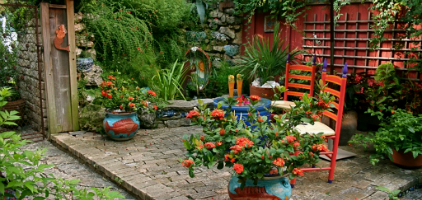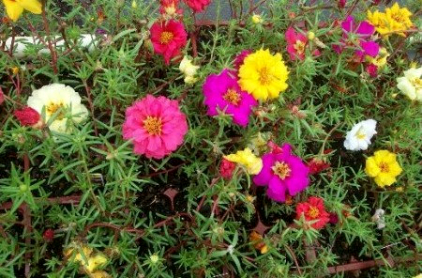by Chris Winslow
1. Spring vegetable gardening: Plant those warm season crops.
This list includes beans, black-eyed peas, okra, squash, canta-
loupe, tomatoes, peppers, cucumbers, watermelon, corn, and egg-
plant. There's still time to plant those cooler season crops: lettuce,
radishes, and carrots.
____________________________________________________
2. Fertilize your garden: Do this organically with compost. Other
sources of nutrition are dried fish flakes and organic fertilizers for-
mulated for garden use. You can also use liquid fertilizers, such as
fish emulsion and seaweed extracts.
____________________________________________________
3. Control weeds: Keep them down with mulch and by weeding
a little bit every day.
____________________________________________________
4. Plant spring annuals: This is the perfect time. Work some com-
post into your flower beds and you'll give these new plants just the
food they need to flower through the summer. Some ideas: begonias,
zinnias, marigolds, petunias, coleus, periwinkle, cosmos, larkspur,
portulaca (pictured above) and purslane.
____________________________________________________
5. Plant perennials: Choose some of your favorites from the exten-
sive lists available, or visit your neighborhood nursery and browse.
Look for the many varieties of drought tolerant and showy lantanas
and salvias. Also blackfoot daisies, skullcaps, purple coneflowers,
black-eyed Susan, plumbagos, columbines, rockrose, ruella, and
verbena.
____________________________________________________
6. Ornamental grasses: Native varieties are best due to their heat
and drought tolerance. My favorites are big muhley, coastal muhley
and the maiden grasses. For a short grass in a very dry place, you
might like Mexican feather grass. It is blond-colored, reaches 1.5
foot in height, and makes a beautiful accent plant that moves so
gracefully with the slightest breeze.
____________________________________________________
7. Fertilize lawn: Use a slow release organic fertilizer. The 3-1-2
ratio is best. Allow 10 pounds of fertilizer for every 1,000 square
feet of lawn. Mowing height should be 2.5 inches for St. Augustine
grass and 2 inches for Bermuda and zoysia. I like to return the grass
clippings to the turf. These clippings act as a mulch and help to
reduce weeds. Water infrequently and deeply to encourage a deep
root system. This practice will train your lawn grass to be more
drought tolerant and help to conserve water.
____________________________________________________
8. Fertilize shrubs, trees: Mulch with a compost-mulch blend to
provide nutrients and conserve water. Deep, infrequent watering
of shrubs and trees will encourage deep, drought-tolerant root
systems. Remember to seal pruning cuts on oak trees. It might
save them from oak wilt.
Happy 2018 springtime gardening everyone! ❦






